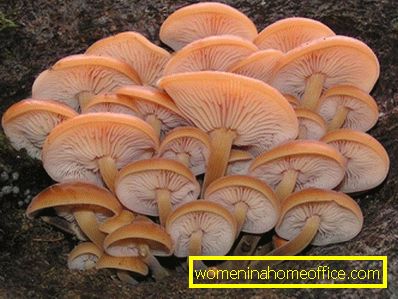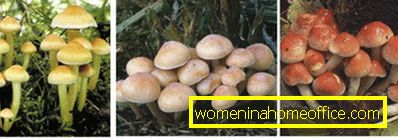How to distinguish the mushrooms from the false
Picking mushrooms is an exciting and useful occupation in all senses, but quite complicated. After all, some representatives of this kingdom have dangerous poisonous twins, which not everyone can recognize. In particular, it is important to know how to distinguish edible mushrooms from false ones: the main features characteristic of each species, as well as subtleties and tricks, after which you will definitely not pick and not eat the wrong mushroom.
How to distinguish between edible mushrooms from false?
Initially, it is worthwhile to figure out what the correct shape looks like, and what features are characteristic of it. After that, it is already possible to consider groups of false agarics, isolating their key differences from the edible type, since they have quite a lot of poisonous counterpart.
Three types of mushrooms from existing 34 are used for food: these are summer, autumn and winter, most of which grow on stumps. Of the entire vast family, a different habitat - namely, meadows - is characteristic only of meadow grass.

Winter mushrooms are best known to mushroom pickers, although the time of harvest, as the name implies, is not a rainy autumn. Behind the winter mushrooms walk when the snow falls. They are found mainly on deciduous trees that are damaged, as well as on poplars or willows. The head of the winter garland is small, its diameter does not exceed 10 cm, it is completely flat, has a brown-red color, but sometimes it turns pale to golden yellow. Young fungi have uneven color: the greatest concentration of color in the center, and the edge only barely touched by a shade. The dense tubular leg is painted in deep brown, barely 7 cm tall. The plates under the cap are thin and sparse.
Autumn honeycomb is a more traditional mushroom, but a little less collected than a winter one. Despite the fact that it is edible, it is a parasitic mushroom that is not picky about its environment. Therefore, it is possible to meet it not only on damaged wood, but also on potatoes. And yet, the most characteristic places for him are alder and elm, as well as birch and aspen. Mystical stories about luminous mushrooms are connected with autumn honey agarics, since at night they are capable of weakly highlighting the stumps on which they sit.
Among other species of honey, this one grows in the most dense family: from one outlet one can count up to 50 mushrooms. Hats are quite large, reach a diameter of 17-18 cm, uniform color, olive-brown, darkens with age. The shape of the cap depends on how much the mushroom has already lived. Young specimens have a convex core, mature - wavy edges. The stem is short, 10 cm in height, can be covered with rare scales, which sometimes go to the caps of young mushrooms.

Summer shade - the last representative of edible species of honey agaric. It grows in areas of deciduous forests, like winter moth. His period mirrors the date of the last gathering: from the beginning of spring to the end of autumn, marked by the falling of snow. From 1 rosette of mushrooms grows a little less than that of autumn mushroom: up to 30-40 pcs., But their main place is rotten stumps and fallen trees. The cap is small, up to 5-6 cm in diameter, curved in young individuals and only with a small tubercle in the center - in mature ones. The color is golden brown, darkens at high humidity and brightens - in dry periods.
The cap is so thin that, when the color changes, it can become translucent. Only grooves at the edge remain unchanged, as well as a slight mucus of the surface. The height of the legs is almost equal to this indicator for the winter garland - 6-7 cm, the density is the same, and the main difference, in addition to the time of appearance, is small scales under the ring.
Mushrooms false and edible: photos and key features

Now that you know which species are used in food, you can consider a group of their false counterparts and highlight the features of these twins. Absolutely all instances cannot be mentioned, since there are more than 30 of them, but not all are found in the middle lane.
Externally, false mushrooms can easily confuse at least their place of growth. In the same way as edible ones, they settle on damaged areas of trees and stumps, and also grow immediately by families, gathering tightly in a “bush” of 30-40 individuals. They also try to resemble edible brethren with the color and shape of the cap, but here everything is not so perfect. In particular, the edges of the head of the false powder are often sloppy, as if someone had cut them off - they can hang down with thin translucent flakes, which are often inexperienced mushroom pickers take for the remnants of a filmy ring.
This is the most important sign that will help you in the identification of honeydew - a membranous ring located under the cap. Its edges go down, which is why some mushroom pickers call it "skirt" for ease of understanding. This ring is the remainder of the film that protected the body of the fungus at the initial stage of development, and it is inherent only in edible mushrooms. False species do not have it at all.

However, edible garlic for any reason may lose its "skirt", so you should pay attention to other details. For example, the color of the cap. As it was possible to notice from the information presented earlier, edible mushrooms are characterized by a gamut of golden-brown shades, muffled and deep. The same cannot be said about the false specimens: they only draw attention to their color and signal danger, like a bright red fly agaric. The bulk of false honey agarics has brick-red, acid-yellow, and similar-colored caps, and in some cases canary-yellow legs are seen. In addition, the grayish tint of the cap also indicates that the honeydew in front of your eyes is not edible.
Next you need to look under the cap, considering the shade of the plates adjacent to it. If they have an absolutely unattractive green or yellow color, or are generally prone to blackening, you are holding a false shadow in your hands. Edible species in any color of the cap are always characterized by plates of cream or golden white. On the same cap, one can pay attention to the presence of small scales, but this factor should be taken into account only in the case when a young mushroom has received research. Mature individuals, as noted earlier, have a completely smooth surface.
Video help and tips for novice mushroom pickers

So, the main parameters that make it possible to attribute the found hair to a false or edible group are the color of the cap and plates, the presence or absence of gray-brown scales concentrated in the center of the cap, and a membranous ring. It is necessary to check every detail, because, for example, the summer false honey shade does not differ much from its edible counterpart - it is just as delicate, not conspicuous.
Even a smooth plate of a mature individual, and even a height of a stem with a hat diameter, will not cause suspicions: here everything is almost identical to the edible shrub. In some cases, the remainder of the filmy bedspread is also present. The decisive factor is the color of the plates - gray-yellow, absolutely unattractive, the same shade of the pulp of the fungus, and a hollow leg. In contrast to her edible summer powder, she is strong and dense. At this point, inexperienced mushroom pickers rarely pay attention, but in vain: having just broken a mushroom, one can say with certainty whether it should be eaten.

The last nuance, which can also help in the identification of the honey agaric - its smell and taste. He is resorted to when the mushroom has already been brought home, but is still in doubt, and previous checks could not give an unambiguous result. Firstly, the taste of false agarics has a pronounced bitterness, and it is unlikely he will be able to induce you to further tasting the product. If this didn’t bother you, you need to evaluate the flavor. You should not feel the mold in the general pyramid - no foreign notes are added to the traditional mushroom flavor of edible mushrooms.
In any case, if doubts come to you when picking mushrooms - false mushrooms you have met, or edible ones, it would be wiser to refuse an ambiguous specimen, since here experiments often turn out to be dangerous. Put in your basket only those mushrooms, the identity of which can be established with confidence: it will save the health of you and your loved ones.